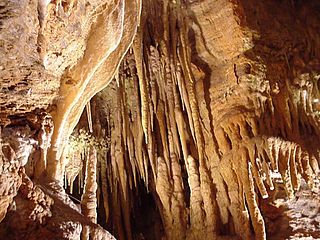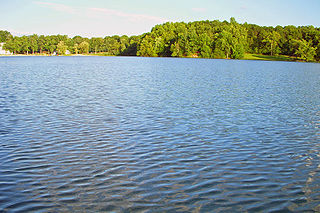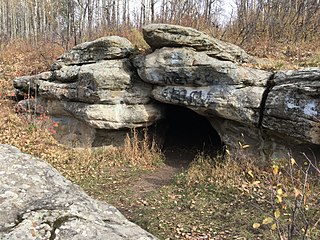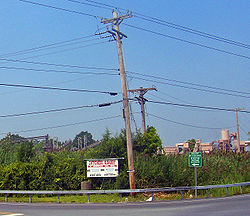
Orange County is a county located in the U.S. state of New York. As of the 2010 census, the population was 372,813. The county seat is Goshen. This county was first created in 1683 and reorganized with its present boundaries in 1798.

Hudson Highlands State Park is a non-contiguous state park in the U.S. state of New York, located on the east side of the Hudson River. The park runs from Peekskill in Westchester County, through Putnam County, to Beacon in Dutchess County, in the eastern section of the Hudson Highlands.

The Orange County Government Center, located on Main Street in Goshen, New York, was the main office of the government of Orange County. It housed most county officials' offices and meetings of the county legislature. The records of Orange County Court and all deeds and mortgages filed in the county were kept there as well. An office of the New York State Department of Motor Vehicles was located on the first floor.

Fishkill Creek is a tributary of the Hudson River in Dutchess County, New York, United States. At 33.5 miles (53.9 km) it is the second longest stream in the county, after Wappinger Creek. It rises in the town of Union Vale and flows generally southwest to a small estuary on the Hudson just south of Beacon. Part of its 193-square-mile (500 km2) watershed is in Putnam County to the south. Sprout Creek, the county's third-longest creek, is its most significant tributary. Whaley and Sylvan lakes and Beacon Reservoir, its largest, deepest and highest lakes, are among the bodies of water within the watershed.

The Van Wyck Homestead Museum or Van Wyck-Wharton House is an early 18th-century Dutch colonial house in the Town of Fishkill, New York, United States of America. It served as a headquarters to a major military supply depot during the American Revolutionary War and has been listed on the National Register of Historic Places since April 13, 1972; the adjoining Fishkill Supply Depot Site has been listed on the NRHP since January 21, 1974. It is located on US 9 just south of Interstate 84. Excavations during the construction of a nearby gas station and the Dutchess Mall in the early 1970s unearthed many artifacts at the site, particularly materiel.

District School No. 9, sometimes referred to as the Old Stone Schoolhouse, is located on NY 17A 1.4 mile (2.3 km) south of Goshen, New York. One of the first schools in the county, it remained in use for well over a century, possibly two. It is believed to be both the oldest and longest-used one-room schoolhouse in the United States.

The Wallkill Valley Rail Trail is a 22.5-mile (36.2 km) rail trail and linear park that runs along the former Wallkill Valley Railroad rail corridor in Ulster County, New York. It stretches from Gardiner through New Paltz, Rosendale, and Ulster to the Kingston city line. The trail is separated from the Walden–Wallkill Rail Trail by two state prisons in Shawangunk, though there have been plans to bypass these facilities, and to connect the Wallkill Valley Rail Trail with other regional rail trails. The northern section of the trail forms part of the Empire State Trail.

Muddy Kill is a 4.2-mile-long (6.8 km) tributary of the Wallkill River that runs entirely through the town of Montgomery in Orange County, New York, United States. It rises from a small pond just over a mile (1.7 km) west of the village of Walden, flowing first southwesterly then roughly due south to empty into the Wallkill just upstream from the village of Montgomery.

Crystal Grottoes is the only show cave in the U.S. state of Maryland. It is located on Maryland Route 34 between Boonsboro and Antietam National Battlefield.

Swanscombe Skull Site or Swanscombe Heritage Park is a 3.9 hectares geological Site of Special Scientific Interest in Swanscombe in north-west Kent, England. It contains two Geological Conservation Review sites and a National Nature Reserve. The park lies in a former gravel quarry, Barnfield Pit.

Sylvan Lake is located next to the community by that name in the Town of Beekman, New York, United States. It is the deepest and second-largest lake in Dutchess County.

The Makauwahi Cave is the largest limestone cave found in Hawaii. It lies on the south coast of the island of Kauaʻi, in the Māhāʻulepū Valley close to Māhāʻulepū Beach, and is important for its paleoecological and archaeological values. It is reached via a sinkhole and has been described as “…maybe the richest fossil site in the Hawaiian Islands, perhaps in the entire Pacific Island region”.

The Rosendale Trestle is a 940-foot (290-meter) continuous truss bridge and former railroad trestle in Rosendale Village, a hamlet in the town of Rosendale in Ulster County, New York. Originally constructed by the Wallkill Valley Railroad to continue its rail line from New Paltz to Kingston, the bridge rises 150 ft (46 m) above Rondout Creek, spanning both Route 213 and the former Delaware and Hudson Canal. Construction on the trestle began in late 1870, and continued until early 1872. When it opened to rail traffic on April 6, 1872, the Rosendale trestle was the highest span bridge in the United States.
The history of Sussex County, New Jersey spans over 13,000 years from the time Paleo Indians arrived after the Wisconsin glacier melted to the present day, and the entire width of the American experience.

The Charlie Lake Cave (Tse'KWa) is an archaeological site in the Canadian province of British Columbia. Its Borden System designation is HbRf 39. In a waste pit in front of the small cave artifacts up to 10,500 years old have been found, which are considered to be the oldest evidence of ritual acts in Canada. The cave is located a few kilometers north of Fort St. John, near Charlie Lake.

Sheridan Cave is a Paleo-Indian archaeological site from the late Ice age in Wyandot County, Ohio. Glacial deposits sealed off the cave more than 10,000 years ago. Sheriden Cave is a karst sinkhole on a dolomite ridge that crosses Hancock and Wyandot Counties. It is associated with the Indian Trail Caverns that opened in 1927. Sheriden Cave was discovered in 1989. The cave is unique because in addition to stone tools, there were also bone tools, remains of extinct animals, and organic matter found in the cave. Radiocarbon dating of artifacts indicate that they were used 11,000 and 12,000 years ago.

Welling Site is an archaeological site of the Paleo-Indian period, meaning the time of the earliest humans. Located in Coshocton County, Ohio, it was a site for quarrying stone in the Upper Mercer chert source area. Based upon the microwear analysis of stone tools, it is believed to be a base camp where people learned and shared Clovis tool-making techniques, ate, exchanged information, and perhaps found mates from others groups.

Stonehaven is a former community in the Town of Belgium, Ozaukee County, Wisconsin, United States. From 1901 until 1925, the community was a company town of the Lake Shore Stone Company, which operated a 25-acre dolomite quarry in the area near the western shore of Lake Michigan. The land is now the site of Harrington Beach State Park.




















